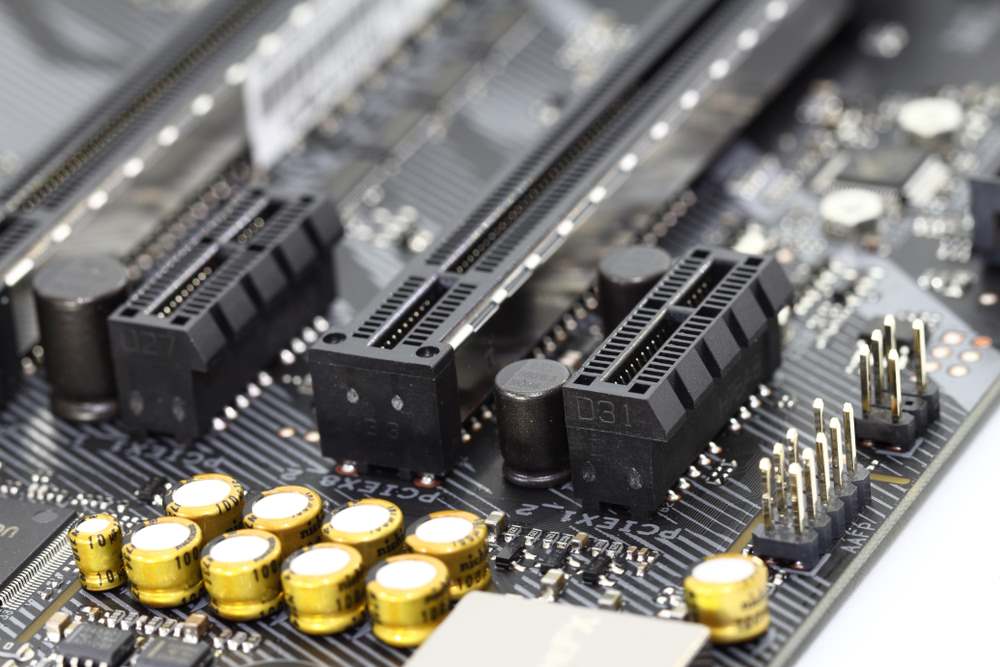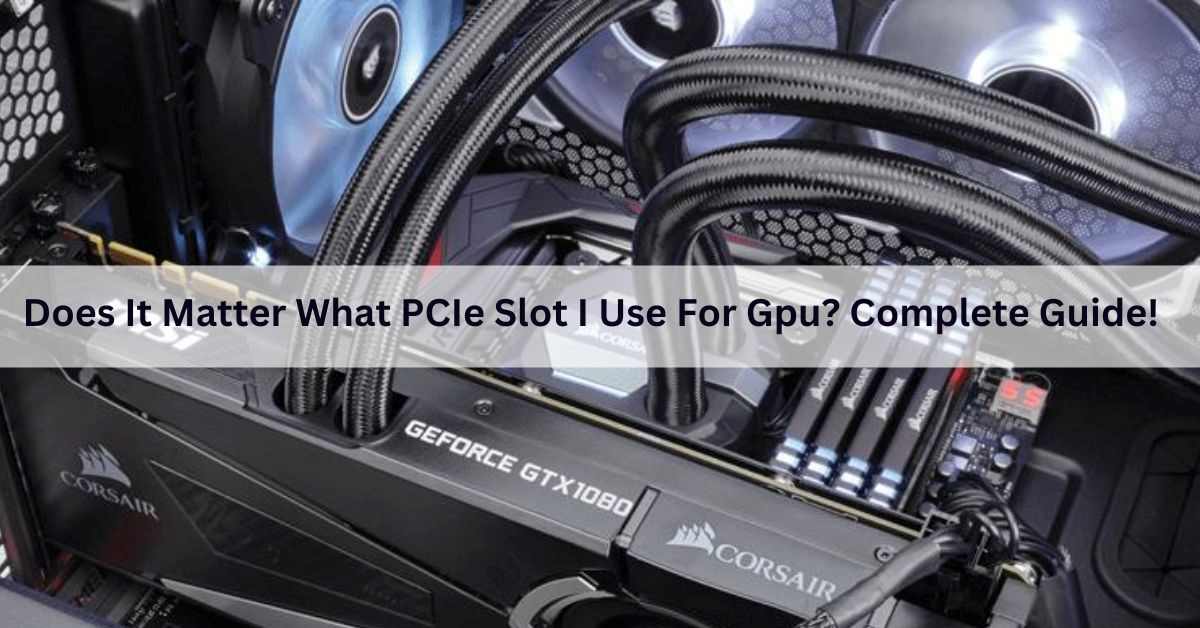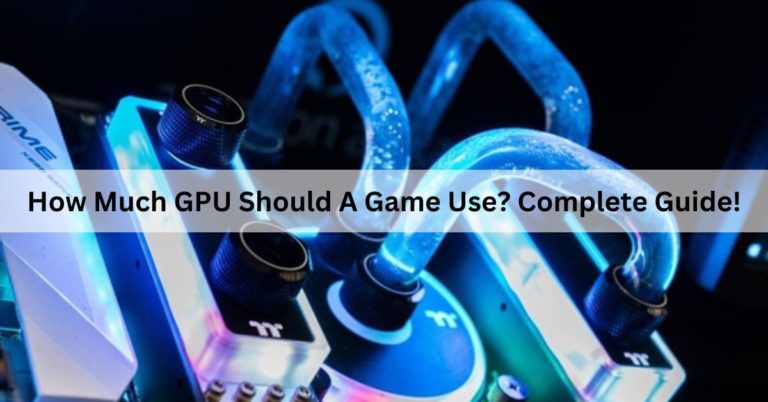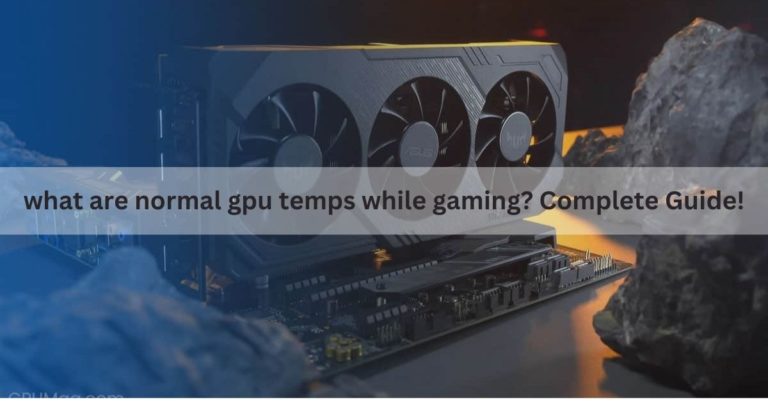Does It Matter What PCIe Slot I Use For Gpu? Complete Guide!
Many modern motherboards feature multiple PCIe slots, each with varying speeds and configurations, which can leave users wondering if it really matters which slot they use for their GPU.
Yes, it matters which PCIe slot you use for your GPU. Optimal performance is achieved when using the primary PCIe x16 slot closest to the CPU, ensuring the best graphics card performance.
In this article, we’re about to dive deep into the world of PCIe slots and why choosing the right one for your GPU can make all the difference in your system’s performance.
Understanding PCIe Slots?
Before we delve into the matter at hand, let’s take a closer look at PCIe slots. PCIe is a high-speed interface that connects various components to the motherboard, including GPUs, sound cards, and storage devices.
These slots come in different sizes: PCIe x1, PCIe x4, PCIe x8, and PCIe x16, with the latter being the most common for GPUs.
Also read: Do Both Monitors Need To Be Connected To The Gpu? Complete Guide!
PCIe x1 Slots?
PCIe x1 slots are the smallest and least powerful among the PCIe options. They are typically used for peripheral cards like sound cards, Wi-Fi cards, or additional USB ports.
While you can technically plug a GPU into a PCIe x1 slot using an adapter, it’s not recommended for gaming due to the limited bandwidth.
PCIe x4 and PCIe x8 Slots?
These slots offer more bandwidth than PCIe x1, making them suitable for tasks that require higher data transfer rates, such as RAID controllers or NVMe SSDs.
However, they are still not ideal for gaming GPUs, as they may bottleneck the card’s performance.
Also read: Do GPU fans always spin? – Causes And Fixed – 2023
The Importance of PCIe x16 for Gaming?
When it comes to gaming, PCIe x16 slots are the gold standard. These slots provide the maximum bandwidth and are specifically designed for graphics cards.
Plugging your GPU into a PCIe x16 slot ensures that it can communicate with the rest of your system at full speed, delivering the best gaming performance possible.
Does It Matter Which PCI-e x16 Slot I Use?

Yes, it matters which PCI-e x16 slot you use. The PCI-e x16 slot closest to the CPU is typically the primary slot and provides the maximum bandwidth for your GPU, ensuring optimal performance. Using a different slot may result in reduced GPU performance.
Is The Pci-e X16 Slot I Use That Important?
Yes, the PCI-E x16 slot you use is essential. For the best performance, always use the primary PCI-E x16 slot closest to the CPU for your GPU.
Using a different slot can affect your graphics card’s speed and overall performance. So, choosing the right slot is crucial for a smoother experience.
Which PCIe Slot is best for your Graphics Card?
The best PCIe slot for your graphics card is the primary PCIe x16 slot nearest to the CPU. This slot offers the highest bandwidth, ensuring optimal performance for your GPU.
Using other slots may result in reduced graphics card speed and overall performance, so it’s essential to choose the right one.
Will My Graphics Card Work In All Pcie Slots?
Generally, graphics cards are compatible with various PCIe slots, but compatibility depends on factors like slot type (e.g., PCIe x16, x8) and card design. Most modern GPUs work in PCIe x16 slots, but some can also function in x8 slots with reduced bandwidth. Check your card and motherboard specifications for optimal compatibility.
PCIe Lanes – or Why Slot Choice Matters?
PCIe lanes, and your slot choice matters for your graphics card’s performance. Opt for the primary PCIe x16 slot closest to the CPU, as it offers the most lanes and maximum bandwidth.
Using other slots can limit your GPU’s speed, affecting overall performance. So, choose wisely for better results.
Finding Which PCIe Slot For Your Graphics Card Is Best?
To find the best PCIe slot for your graphics card, use the primary PCIe x16 slot located closest to the CPU.
This slot provides the highest bandwidth, ensuring optimal performance for your GPU. Selecting the right slot is crucial to maximize your graphics card’s capabilities and overall system performance.
PCIe Slots vs PCIe Lanes?
PCIe slots and PCIe lanes are different aspects of your motherboard. PCIe slots are physical connectors where you install components like GPUs. PCIe lanes are data pathways that carry information between these components and the CPU.
The number of lanes affects data transfer speed, while slots determine where you can connect hardware.
Which PCIe Slots To Use For Multi-GPU Setups?
For multi-GPU setups, use PCIe x16 slots for each graphics card, ensuring the best performance. These slots offer the most bandwidth.
Check your motherboard’s manual for optimal slot configurations, but generally, using identical slots, if available, will help distribute the load evenly and maximize performance in multi-GPU configurations.
PCIe x16 with 8 and 4 lanes?

PCIe x16 slots with 8 and 4 lanes are common in some motherboards. These slots physically look like x16 but provide reduced bandwidth (8 and 4 lanes, respectively).
They can accommodate smaller GPUs but may limit performance compared to full x16 slots, making them suitable for budget or secondary graphics cards
PCIE PRIMER: SLOTS, SPEED, AND LANES?
A PCIe primer: PCIe slots, speed, and lanes are crucial components of your motherboard. PCIe slots physically hold your components, with x16 being common for graphics cards. Speed determines data transfer rates, and lanes dictate the bandwidth.
More lanes typically mean faster data transfer, which is important for high-performance components like GPUs.
Slot Selection and Compatibility?
Slot selection involves choosing the right option for compatibility. Ensuring that components fit together seamlessly is essential for optimal performance.
1. Primary and Secondary Slots:
Primary and secondary slots are like main and backup options. Primary is the main choice, while secondary is a backup in case the primary one doesn’t work.
2. Bad Ports:
Bad ports are like broken doors. They don’t let things go in or out properly. When a port is bad, it can’t be used for connecting devices.
3. SLI and CrossFire:
SLI and CrossFire are like teamwork for graphics cards. They help cards work together to make games and videos better by sharing the load and improving performance.
Where You Shouldn’t Install Your Graphics Card?
Avoid installing your graphics card in smaller PCIe slots like PCIe x1 or x4 slots. These slots lack the necessary bandwidth for optimal GPU performance.
Instead, use the primary PCIe x16 slot closest to the CPU for the best graphics card performance in your system.
Also read: Is It Okay For My Gpu To Be At 100? – Check GPU Temperature
What About Mini ITX and Micro ATX Motherboards?
Mini ITX and Micro ATX motherboards have fewer PCIe slots than standard ATX motherboards.
While they may offer fewer options for installing additional components like GPUs, it’s crucial to use the available PCIe x16 slot for your graphics card. Choosing the right slot is still essential for optimal performance.
Do Laptops Have PCI Express Slots?
Most laptops do not have traditional PCIe slots like desktop motherboards. Laptops use integrated GPUs soldered onto the motherboard, making GPU upgrades impossible.
Some gaming laptops have external GPU (eGPU) support via Thunderbolt 3/4 ports, allowing you to connect an external GPU for improved graphics performance.

Does It Matter Which Pcie Slot I Put My Gpu In?
Yes, it matters which PCIe slot you use for your GPU. For optimal performance, use the primary PCIe x16 slot closest to the CPU.
Other slots may provide less bandwidth, potentially limiting your graphics card’s speed and overall performance. So, choosing the right slot is important for a better gaming experience.
2 gpu slots on mobo can i use either?
If your motherboard has two GPU slots, you can typically use either slot for your graphics card. However, the specific slot choice may affect bandwidth and performance, so consult your motherboard manual to determine the optimal slot based on your configuration and preferences.
Does It Matter What PCIe Slot A Gpu Needs?
Yes, it matters which PCIe slot a GPU needs. GPUs often require specific PCIe slot types, like PCIe x16. Using an incompatible slot may impact performance. Refer to your GPU and motherboard specifications to ensure compatibility and optimal performance by placing the GPU in the correct PCIe slot.
Frequently Asked Questions:
1. Graphics Card Slot On Motherboard?
The graphics card slot on a motherboard is typically a PCIe x16 slot. It’s where you install your GPU to enable graphics processing and display output on your computer.
2. How Many PCIe Lanes Do I Need?
The number of PCIe lanes you need depends on your hardware requirements. For most GPUs and standard peripherals, a PCIe x16 slot with 16 lanes is sufficient for optimal performance.
3. Does it matter which PCIe slot I put my graphics card in?
Yes, it matters which PCIe slot you use for your graphics card. The primary PCIe x16 slot closest to the CPU offers the best performance and should be used for optimal results.
4. Does a Graphics Card Have to Go in the First PCI-E Slot?
No, a graphics card doesn’t have to go in the first PCI-E slot. However, for optimal performance, it’s recommended to use the primary PCIe x16 slot closest to the CPU.
5. Does it matter which slot I put my GPU in?
Yes, it matters which slot you put your GPU in. The primary PCIe x16 slot closest to the CPU provides the best performance and should be used for optimal GPU performance.
6. Will using a lower-speed PCIe slot damage my GPU?
Using a lower-speed PCIe slot won’t damage your GPU. However, it may limit its performance, affecting graphics-intensive tasks like gaming or rendering.
7. Does it matter which PCIE slot you put a graphics card in?
Yes, it matters. Placing a graphics card in the correct PCIe slot, typically PCIe x16, is crucial for optimal performance. Refer to your GPU and motherboard specifications for compatibility and best results.
8. Does a graphics card have to go in the first PCIE slot?
No, a graphics card doesn’t always have to go in the first PCIe slot. While it’s often placed in the primary PCIe x16 slot for optimal performance, compatibility depends on the motherboard. Check the motherboard manual to determine the recommended slot for your specific configuration.
9. Can you put a GPU into the second PCIe x16 slot of a motherboard?
Yes, you can put a GPU into the second PCIe x16 slot of a motherboard. Many motherboards support multiple PCIe x16 slots for GPUs. Refer to your motherboard manual for specific guidance on GPU installation and optimal slot usage.
10. Can you install a video card into a PCI slot?
No, you cannot install a modern video card into a PCI slot directly. Most contemporary video cards use PCIe (Peripheral Component Interconnect Express) slots, while PCI (Peripheral Component Interconnect) slots are older and have different physical dimensions. Ensure your motherboard and GPU are compatible in terms of slot type.
11. What can I do if my motherboard doesnt have a PCI E slot Can I still somehow install a graphics card in it?
If your motherboard lacks a PCIe slot, options are limited. You might use an older graphics card compatible with available slots (e.g., PCI). Alternatively, consider upgrading your motherboard or using an external GPU (eGPU) via interfaces like Thunderbolt if supported. Evaluate compatibility and performance considerations before making a decision.
12. Are PCIe slots interchangeable?
PCIe slots are not interchangeable in the sense that you can use any type of PCIe card in any PCIe slot. The compatibility depends on factors such as slot size (e.g., PCIe x16, x8) and version (e.g., PCIe 3.0, 4.0). Match the card and slot specifications for proper functionality.
13. Is PCI a graphics card?
PCI (Peripheral Component Interconnect) is a type of expansion slot on a motherboard. It is not a graphics card itself but rather a standard interface for various expansion cards, including graphics cards. Modern graphics cards typically use PCIe (Peripheral Component Interconnect Express) slots rather than the older PCI slots for better performance.
14. Can I install a PCI card in a PCIe slot?
No, you generally cannot directly install a PCI (Peripheral Component Interconnect) card into a PCIe (Peripheral Component Interconnect Express) slot. These slots have different physical configurations and are not directly compatible. Ensure that the card and slot types match for proper installation and functionality.
15. Does it matter what slot I put my graphics card in?
Yes, it matters where you put your graphics card. For optimal performance, place it in the recommended slot, usually the primary PCIe x16 slot on the motherboard. Refer to the motherboard manual and GPU specifications to ensure proper compatibility and to achieve the best results.
16. What happens if you put two graphics cards in the same slot?
You typically cannot physically place two graphics cards in the same slot on a motherboard designed for a single GPU. Most motherboards have multiple PCIe slots, and each graphics card should be installed in a separate slot to function correctly and enable technologies like SLI or CrossFire for improved performance.
17. Which slot should I put my GPU in Does a Graphics Card Have to Go in the First PCI E Slot?
While a graphics card doesn’t always have to go in the first PCIe slot, it’s often recommended for optimal performance. Check your motherboard manual to identify the primary PCIe x16 slot. Placing the GPU in this slot is typically the default choice, but other slots may also be suitable based on your specific motherboard’s design.
FINAL WORDS:
Selecting the right PCIe slot is paramount for GPU performance. The primary PCIe x16 slot closest to the CPU offers the highest bandwidth, ensuring your graphics card operates at its best. Alternative slots can constrain its speed, affecting overall system performance. Therefore, making the correct slot choice is essential for an optimal gaming and computing experience, ultimately determining the success of your system’s graphics capabilities.







